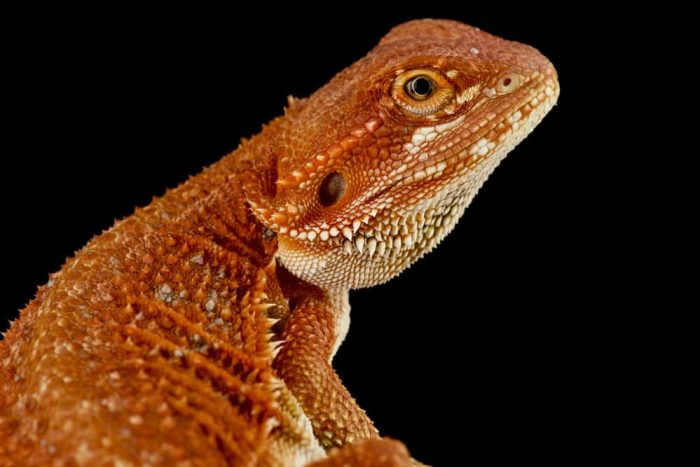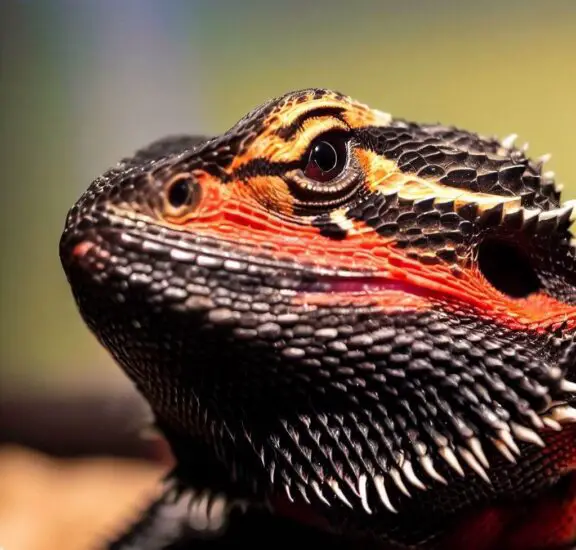
Bearded dragons have become popular pets due to their unique appearance and docile nature. Among the various morphs and color variations, the Black and Red Bearded Dragon stands out as a captivating reptile. In this article, we will explore the world of Black and Red Bearded dragons, their physical characteristics, habitat requirements, feeding habits, temperament, care, and more. Whether you’re a reptile enthusiast or considering getting a bearded dragon as a pet, this guide will provide valuable insights into this fascinating creature.
The Fascinating World of Bearded Dragons
Bearded dragons, scientifically known as Pogona, are native to the arid regions of Australia. They are named “bearded” due to the unique appearance of their throat, which can puff out when they feel threatened or during courtship displays. These reptiles are known for their gentle nature and have gained popularity as pets worldwide.
Bearded dragons are diurnal creatures, meaning they are active during the day and require a warm environment to maintain their body temperature. They have a lifespan of 10 to 15 years, making them long-term companions for reptile enthusiasts. Now, let’s dive into the captivating world of black and red-bearded dragons.
The Black and Red Bearded Dragon: A Rare Beauty
The Black and Red Bearded Dragon is a striking color morph that captivates the eyes of reptile enthusiasts. Unlike the typical bearded dragon colors, this morph showcases a dark, almost black, base coloration with vibrant red or orange patterns. The contrast between the dark background and the intense red markings creates a visually stunning appearance.
This color variation occurs due to genetic traits that affect the production of pigments in their scales. Black and red-bearded dragons are relatively rare and highly sought after among reptile enthusiasts. Their unique coloration adds a touch of exotic beauty to any reptile collection.
 Black and Red-Bearded Dragon
Black and Red-Bearded Dragon
Physical Characteristics
Black and red-bearded dragons have similar physical characteristics to other bearded dragon morphs. They have a stout body with a triangular-shaped head and spiky scales along their body and tail. These reptiles can reach an average length of 16 to 22 inches, with males generally being larger than females.
Their skin is covered in small scales that give them a rough texture. The black and red coloration varies among individuals, with some displaying more black or red pigmentation than others. Additionally, their scales may have patterns or bands that further enhance their unique appearance.
Habitat and Enclosure Setup
Creating a suitable habitat is crucial for the health and well-being of your black and red-bearded dragon. Their enclosure should mimic their natural environment, providing them with ample space to move, bask, and explore. Here are some key factors to consider:
- Enclosure Size: A minimum enclosure size of 40 gallons is recommended for adult black and red-bearded dragons. Larger enclosures are always
- Substrate: Choose a substrate that is safe and easy to clean. Options like reptile carpets, paper towels, or ceramic tiles work well for black and red-bearded dragons.
- Temperature and Lighting: Bearded dragons require a basking spot with a temperature of around 95°F to 105°F (35°C to 40°C) and a cooler side of the enclosure around 80°F (27°C). Use a combination of heat lamps and UVB lighting to provide the necessary warmth and UV radiation for their well-being.
- Hideouts and Climbing Structures: Incorporate rocks, branches, and logs in the enclosure to create climbing opportunities and hiding spots. This will help replicate their natural habitat and provide enrichment.
- Water and Humidity: While bearded dragons don’t require standing water, provide a shallow dish of water for drinking and occasional soaking. Maintain a humidity level of around 30% to 40%, which can be achieved by misting the enclosure or providing a humidity hide.
Feeding and Nutrition
Proper nutrition is essential for the health of your black and red-bearded dragon. Their diet should consist of a variety of insects, vegetables, and occasionally, fruits. Here are some guidelines to ensure a balanced diet:
- Insects: Feed your Black and Red Bearded Dragon a variety of appropriately-sized insects, such as crickets, mealworms, and dubia roaches. Dust the insects with calcium powder before feeding to provide essential nutrients.
- Vegetables: Offer a wide range of leafy greens and vegetables, including collard greens, dandelion greens, squash, and bell peppers. These should make up the majority of their diet.
- Fruits: Fruits should be given as occasional treats due to their high sugar content. Offer small portions of fruits like berries, mangoes, and melons.
- Supplements: Calcium and vitamin supplements are crucial for maintaining proper bone health. Dust the insects with calcium powder and provide a reptile multivitamin once or twice a week.
Remember to provide fresh water daily and remove any uneaten food to maintain a clean and hygienic enclosure.
Temperament and Handling
Black and Red Bearded Dragon, like other bearded dragon morphs, are known for their docile nature. With proper handling and socialization, they can become accustomed to human interaction. Here are some tips for handling your bearded dragon:
- Approach with Care: Approach your bearded dragon calmly and avoid sudden movements. Allow them to see your hand before attempting to pick them up.
- Support the Body: When handling your bearded dragon, support its body and avoid gripping them tightly. Use both hands to ensure a secure and comfortable hold.
- Start with Short Sessions: Begin with short handling sessions of a few minutes and gradually increase the duration as your bearded dragon becomes more comfortable.
- Watch for Stress Signals: Be observant of your bearded dragon’s behavior. If they show signs of stress, such as puffing out their beard, flattening their body, or hissing, gently place them back in their enclosure.
Remember, each bearded dragon has its personality, so it’s important to respect its boundaries and provide a stress-free environment.
Health and Care
To keep your Black and Red Bearded Dragon in optimal health, regular care and monitoring are necessary. Here are some essential aspects to consider:
- Veterinary Check-ups: Schedule regular visits to a reptile veterinarian for routine check-ups and to address any health concerns.
- Hygiene: Maintain a clean enclosure by regularly spot cleaning and deep cleaning as
- Observation: Monitor your bearded dragon for any signs of illness or distress, such as loss of appetite, lethargy, abnormal feces, or respiratory issues. Seek veterinary attention if you notice any concerning symptoms.
- Shedding: Bearded dragons shed their skin as they grow. Ensure proper humidity levels and provide a humid hide to assist with clearing. If your bearded dragon is having difficulty clearing, consult a veterinarian.
- Nail Trimming: Regularly check and trim your bearded dragon’s nails to prevent overgrowth and potential injuries.
- Preventing Impaction: Bearded dragons can accidentally ingest substrate or other foreign objects, leading to impaction. Use a substrate that is safe for ingestion or consider using non-particulate alternatives like reptile carpets.
By providing proper care, nutrition, and attention, you can help ensure the well-being and longevity of your black and red-bearded dragon.
Breeding and Reproduction
Breeding Black and Red Bearded Dragons requires careful planning and knowledge of their specific requirements. If you’re interested in producing these reptiles, consider the following:
- Maturity: Bearded dragons reach sexual maturity at around 1 to 2 years of age. Ensure that both the male and female dragons are healthy and of appropriate size before attempting breeding.
- Introducing the Pair: Introduce the male and female in a separate breeding enclosure and closely monitor their behavior. Mating behavior includes head bobbing, arm waving, and tail curling.
- Egg Laying: Provide a suitable nesting area with a mixture of sand and soil for the female to lay her eggs. Maintain proper temperature and humidity levels to ensure successful incubation.
- Incubation: Carefully collect the eggs and place them in an incubator with controlled temperature and humidity. Monitor the incubation period and make any necessary adjustments to optimize hatch rates.
Breeding bearded dragons requires expertise and should only be undertaken by experienced reptile breeders. It’s important to research and understand the breeding process thoroughly before attempting it.
Conclusion (Black and Red Bearded Dragon)
The Black and Red Bearded Dragon is a visually stunning and unique reptile that has captivated the hearts of reptile enthusiasts worldwide. With their striking coloration, gentle temperament, and interesting behaviors, they make fascinating pets for both experienced reptile keepers and beginners. By providing them with suitable habitat, balanced nutrition
Black and Red-Bearded Dragon
FAQs (Black and Red Bearded Dragon)
No, black and red-bearded dragons are not inherently aggressive. With proper care and handling, they can be docile and friendly reptiles.
Bearded dragons are generally solitary reptiles and may not tolerate the presence of other reptiles in their enclosure. It’s best to house them separately.
Juvenile bearded dragons should be fed insects daily, while adult dragons can be fed insects every other day, supplemented with various vegetables and occasional fruits.
Black and red-bearded dragons have a lifespan of around 10 to 15 years with proper care and nutrition.
Yes, black and red-bearded dragons require a combination of heat lamps and UVB lighting to provide the necessary warmth and UV radiation for their health.
